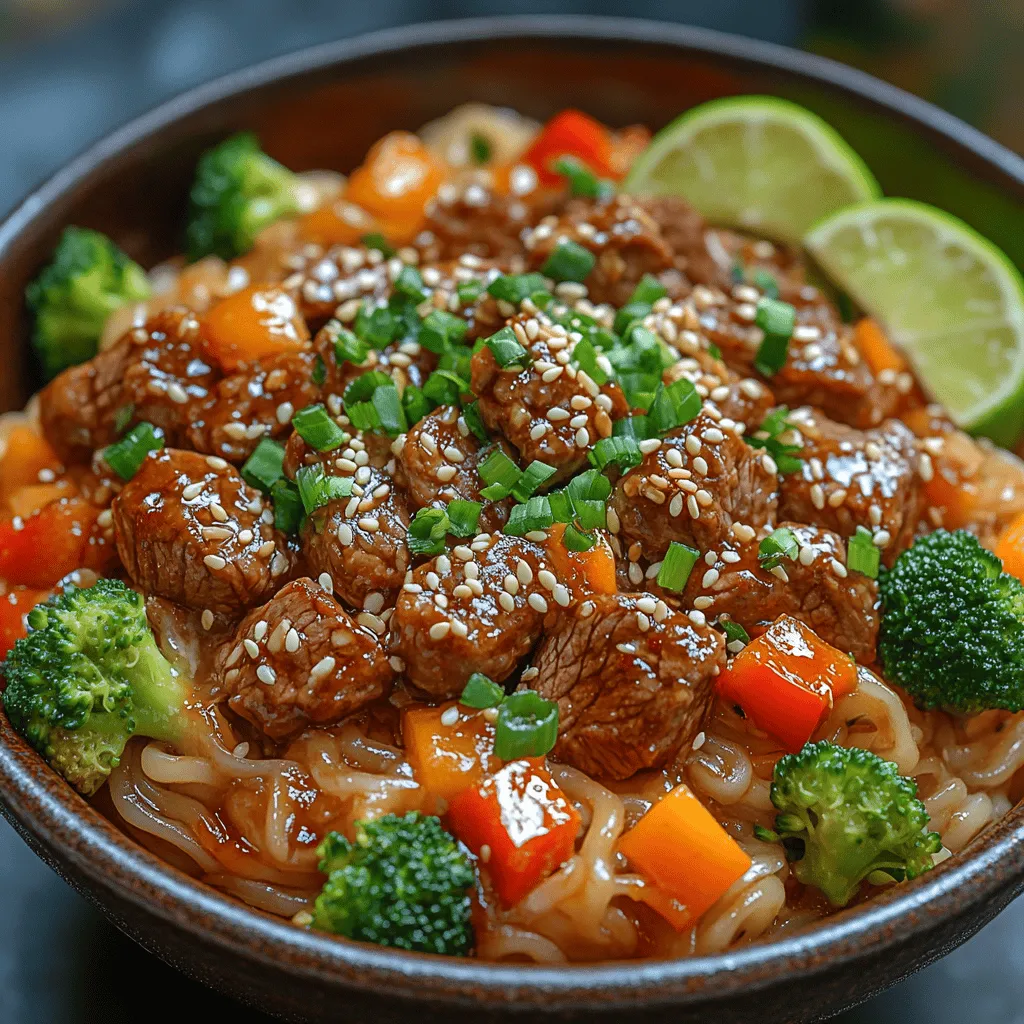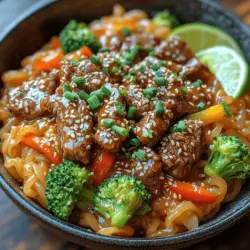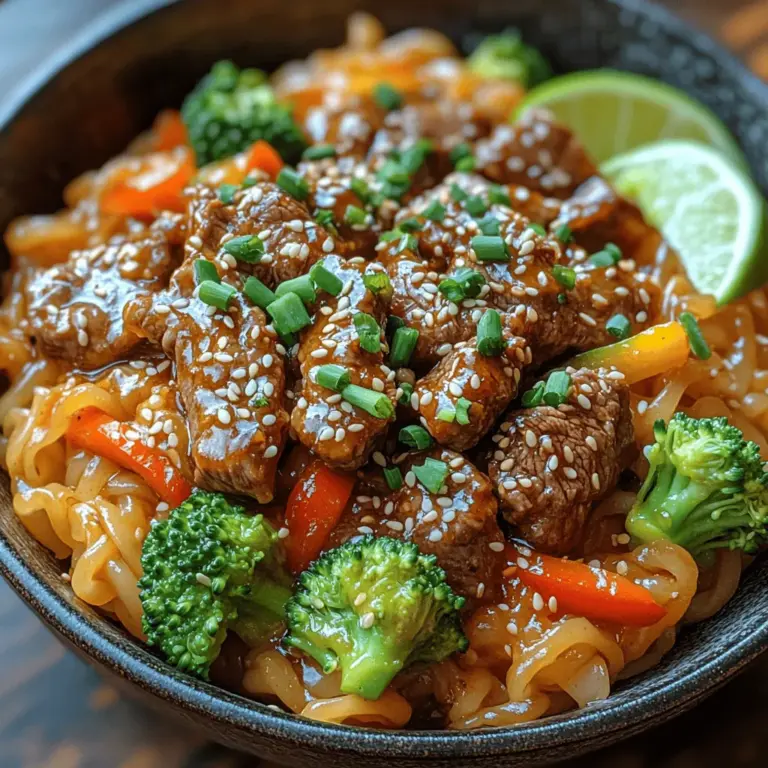Introduction
Hoisin Beef Noodles is a vibrant dish that beautifully encapsulates the essence of Asian cooking. Originating from the rich culinary traditions of East Asia, this recipe has rapidly gained traction across the globe, becoming a beloved staple in many households and restaurants alike. The dish is a delightful harmony of textures and flavors, showcasing tender slices of beef, vibrant vegetables, and soft, slippery rice noodles, all enveloped in a rich, sweet, and savory hoisin sauce.
Hoisin sauce, often referred to as Chinese barbecue sauce, serves as the backbone of this dish, imparting a distinctive depth of flavor that tantalizes the taste buds. The combination of sweetness from the hoisin, saltiness from the soy sauce, and the aromatic notes from sesame oil creates a taste profile that is both complex and satisfying. What makes Hoisin Beef Noodles particularly appealing is its versatility; it can be adjusted to suit individual preferences or dietary requirements, making it a go-to meal for many.
Whether you’re looking to impress guests at a dinner party or simply wish to indulge in a hearty, home-cooked meal, Hoisin Beef Noodles promises to deliver a delightful culinary experience. Let’s dive deeper into the essential ingredients that bring this dish to life and explore the preparation steps that will ensure your version is a triumph.
Exploring the Ingredients
Creating the perfect Hoisin Beef Noodles requires a careful selection of ingredients, each contributing unique flavors and textures to the overall dish. Here’s a closer look at the essential components:
Flat Rice Noodles
Flat rice noodles, often used in Asian cuisine, are characterized by their smooth texture and ability to absorb flavors. Unlike their wheat-based counterparts, these noodles are gluten-free and offer a chewy consistency that pairs well with rich sauces. When cooked properly, they become the perfect vehicle for carrying the hoisin sauce and other flavors throughout the dish. They are best soaked in hot water until pliable, then rinsed to prevent clumping, ensuring that they remain separate and easy to stir-fry.
Beef Sirloin
Beef sirloin is the ideal cut for this recipe due to its tenderness and quick cooking properties. This cut contains a good amount of marbling, which adds flavor and moisture during the cooking process. When sliced thinly against the grain, sirloin becomes melt-in-your-mouth tender, making it perfect for stir-frying. The key to maximizing its flavor is to marinate it briefly, allowing the beef to absorb the seasoning while retaining its juicy texture.
Hoisin Sauce
Hoisin sauce is a rich, thick condiment that plays a crucial role in this recipe. Made from fermented soybeans, vinegar, sugar, and various spices, it has a unique balance of sweet and savory notes. It adds depth to the dish, enhancing the natural flavors of the beef and vegetables. A generous drizzle of hoisin sauce not only provides a luscious coating for the noodles but also contributes to the overall visual appeal with its glossy finish.
Soy Sauce and Oyster Sauce
Soy sauce and oyster sauce are essential in Asian cooking, providing an umami richness that elevates the flavors of the dish. Soy sauce, with its salty and savory profile, acts as a seasoning that enhances the beef’s natural taste. Oyster sauce adds a slightly sweet and earthy flavor, further enriching the dish’s complexity. Together, these sauces create a well-rounded flavor base that complements the sweetness of the hoisin sauce.
Sesame Oil
Sesame oil is known for its aromatic qualities and nutty flavor, making it a vital ingredient in Hoisin Beef Noodles. A drizzle of sesame oil at the end of cooking not only adds a subtle richness but also enhances the overall fragrance of the dish. It pairs beautifully with the other sauces, tying all the flavors together for a harmonious result.
Fresh Vegetables
Fresh vegetables not only contribute color and crunch but also pack a nutritional punch. Ingredients like garlic and ginger add aromatic qualities and a hint of spice, while red bell peppers bring a sweet crunch and bright color. Broccoli provides a satisfying bite and essential vitamins and minerals. Together, these vegetables not only enhance the dish’s flavor but also balance the richness of the sauces, creating a well-rounded meal.
Garnishes
To elevate Hoisin Beef Noodles in both flavor and presentation, garnishes such as green onions, sesame seeds, and lime wedges are essential. Green onions add a fresh, crisp touch, while sesame seeds contribute a delightful crunch and nuttiness. A squeeze of lime juice brightens the dish, cutting through the richness and adding a zesty finish that tantalizes the palate.
Preparation Steps for Hoisin Beef Noodles
Creating Hoisin Beef Noodles involves several essential steps that ensure optimal texture and flavor. Here’s a detailed breakdown of the cooking process:
Preparing the Noodles
The first step in preparing Hoisin Beef Noodles is to cook the flat rice noodles. Start by bringing a large pot of water to a boil. Once boiling, add the rice noodles and cook according to the package instructions, typically around 4-5 minutes, until they are just tender but still have a slight bite (al dente).
After cooking, it’s crucial to drain the noodles and rinse them under cold water. This step helps to stop the cooking process and prevents the noodles from sticking together. Toss them lightly with a bit of oil to keep them separate while you prepare the rest of the ingredients. Proper noodle preparation is key to ensuring they soak up the flavors of the sauce without becoming mushy.
Marinating the Beef
While the noodles are cooking, it’s time to marinate the beef. Thinly slice the beef sirloin against the grain into strips approximately ¼ inch thick. This technique not only enhances tenderness but also allows the marinate to penetrate the meat more effectively.
In a medium bowl, combine the sliced beef with hoisin sauce, soy sauce, and a drizzle of sesame oil. Allow the beef to marinate for at least 15 minutes; this brief marination time is sufficient for the flavors to infuse into the meat without compromising its texture. For deeper flavor, you can marinate it for up to 30 minutes, but avoid marinating for longer as the beef may become overly salty.
Stir-frying the Vegetables
With the beef marinating, it’s time to stir-fry the vegetables. Heat a large wok or skillet over high heat and add a splash of vegetable oil. To achieve the perfect balance of tenderness and crispness, it’s essential to cook the vegetables in batches. Start with garlic and ginger, sautéing them for about 30 seconds until fragrant.
Next, add the red bell pepper and broccoli florets to the pan. Stir-fry the vegetables for about 2-3 minutes until they are vibrant in color but still crisp. Overcrowding the pan can lead to steaming instead of stir-frying, which is why cooking in batches is crucial. Once the vegetables are cooked, remove them from the pan and set them aside, allowing the flavors to develop while you cook the beef.
Cooking the Beef
Now it’s time to cook the marinated beef. In the same pan, add a bit more oil if necessary and increase the heat to high. Once the oil is shimmering, add the marinated beef in a single layer, ensuring not to overcrowd the pan. This step is vital for achieving a good sear, which locks in the juices and enhances the flavor.
Cook the beef for about 2-3 minutes, allowing it to sear without moving it too much. You’ll know it’s ready to flip when it releases easily from the pan. Stir-fry the beef for another minute or until it’s just cooked through and still tender. Overcooking will lead to tough meat, so keep a close eye on it.
Once the beef is cooked, return the stir-fried vegetables to the pan and add the pre-cooked noodles. Pour in the remaining hoisin sauce and a splash of oyster sauce, tossing everything together until well combined. This step ensures that each ingredient is coated with the rich sauce, creating a delightful fusion of flavors.
—
The journey of preparing Hoisin Beef Noodles is one filled with excitement and anticipation as you bring together the vibrant ingredients in a symphony of flavors. Stay tuned for more detailed cooking tips and common questions to ensure your dish becomes a beloved fixture in your culinary repertoire.

Combining Ingredients
Once all your ingredients are prepped and ready, it’s time to bring everything together to create your delicious Hoisin Beef Noodles. Start by heating a large pan or wok over medium-high heat. Add a splash of cooking oil, and once it’s shimmering, toss in the marinated beef. Stir-fry until it’s browned and just cooked through, which should take about 3-4 minutes. Make sure to spread the beef in a single layer for an even cook.
Next, add your prepared vegetables to the pan. The colorful mix of bell peppers, broccoli, and carrots not only enhances the dish’s visual appeal but also adds texture and nutritional value. Stir-fry the vegetables for about 2-3 minutes until they are tender-crisp.
Once the vegetables are ready, it’s time to add the cooked noodles. Slide them into the pan with the beef and vegetables, and pour in the hoisin sauce, soy sauce, and sesame oil. Gently toss all the ingredients together using tongs or a spatula. It’s important to be gentle during this step to avoid breaking the noodles. Aim for even distribution of flavors, ensuring that every noodle is coated in the rich, savory sauce.
This technique of tossing ingredients is essential; it helps maintain the integrity of the noodles while allowing the flavors to meld beautifully. You may need to adjust the heat slightly during this step to ensure everything is heated through without overcooking the vegetables.
Final Seasoning
Before serving, the final seasoning is a crucial step that shouldn’t be overlooked. Taste your dish and assess whether it requires any adjustments. Depending on your palate, you might want to add a bit more soy sauce for saltiness, hoisin sauce for sweetness, or even a dash of chili sauce for a kick. Remember, the balance of flavors is key in Asian cuisine, so take your time to get it right.
Once you’ve adjusted the seasoning to your liking, remove the pan from heat and prepare for serving.
Serving Suggestions and Pairings
Presenting your Hoisin Beef Noodles beautifully can elevate the dining experience. Use large, shallow bowls or deep plates to serve the noodles, allowing the vibrant colors of the dish to shine. To enhance the meal, consider garnishing with chopped green onions, sesame seeds, or a sprinkle of crushed peanuts for added texture and flavor.
For a well-rounded meal, pair the noodles with Asian-inspired salads that offer a refreshing contrast. A simple cucumber salad dressed with rice vinegar and sesame oil can provide a light, crunchy side. Alternatively, spring rolls or dumplings can complement your main dish perfectly, adding an authentic touch to your meal.
If you prefer a soup starter, a light miso soup or hot and sour soup can warm up your palate before diving into the main course. These pairings not only enhance the overall meal but also create a delightful dining experience that encourages conversation and enjoyment.
Nutritional Information
Hoisin Beef Noodles not only tantalize the taste buds but also provide a wealth of nutritional benefits. A standard serving of this dish contains approximately 450-500 calories, making it a satisfying yet light option for lunch or dinner.
The beef serves as a robust source of protein, with each serving providing around 25-30 grams. This is essential for muscle repair and growth, making it a great choice for active individuals. Additionally, the vegetables included in the dish contribute valuable vitamins and minerals. For example, bell peppers are rich in vitamin C, which supports immune health, while broccoli offers fiber and vitamin K, important for bone health.
The noodles provide carbohydrates, which are crucial for energy, especially if you lead an active lifestyle. Incorporating a variety of vegetables not only enhances the dish’s health profile but also adds fiber, which is beneficial for digestion. Overall, this dish is not just a treat for the senses; it offers nutrients that your body needs to thrive.
Cultural Significance of Hoisin Beef Noodles
Hoisin Beef Noodles find their roots in the rich tapestry of Asian cuisine, particularly Chinese culinary traditions. Hoisin sauce, a thick, fragrant sauce made from soybeans, garlic, vinegar, and spices, is a staple in many Asian dishes. It adds depth and sweetness, reflecting the balance of flavors that is characteristic of Asian cooking.
These noodles are particularly popular in Chinese households but can also be found across various Asian countries, each adding its twist based on local ingredients and preferences. The dish represents the fusion of simplicity and flavor, showcasing how a few key ingredients can come together to create something truly delightful.
In many Asian cultures, meals are often a communal experience, and dishes like Hoisin Beef Noodles are perfect for sharing. It embodies the spirit of togetherness, bringing families and friends around the table to enjoy a flavorful and hearty meal.
Tips for Customizing the Recipe
One of the best aspects of Hoisin Beef Noodles is their versatility. You can easily customize the recipe to suit your dietary preferences or ingredient availability. Here are a few suggestions:
– Protein Substitutions: If you prefer chicken, tofu, or shrimp, feel free to swap the beef for your chosen protein. Each option will bring its unique flavor and texture to the dish. For a vegetarian version, use tofu or tempeh marinated in the same hoisin mixture for a comparable taste experience.
– Adjusting Spice Levels: If you enjoy a bit of heat, consider adding additional chili sauce or fresh chili peppers when cooking. You can also serve sriracha on the side for those who like to spice things up.
– Incorporating Seasonal Vegetables: Depending on the season, you can mix in a variety of vegetables. Snap peas, bok choy, or mushrooms can be excellent additions that not only enhance the flavor but also add nutritional variety.
– Noodle Alternatives: If you’re looking for a healthier alternative, consider using whole grain or rice noodles. Alternatively, gluten-free options like zucchini noodles can also be a great substitute for traditional wheat-based noodles.
Conclusion
Hoisin Beef Noodles represent the perfect combination of flavors, textures, and cultural significance, making it a dish that can easily become a staple in any home kitchen. This recipe is straightforward and quick to prepare, making it an excellent choice for busy weeknights or a special treat for gatherings with family and friends.
With its rich, savory taste and the ability to customize based on personal preferences, this dish not only satisfies hunger but also delights the senses. The vibrant colors and bold flavors of Hoisin Beef Noodles bring the essence of Asian cuisine straight to your table, creating an enjoyable culinary experience that everyone will love. Whether served as a casual meal or an impressive dinner party dish, Hoisin Beef Noodles will surely impress and delight.


